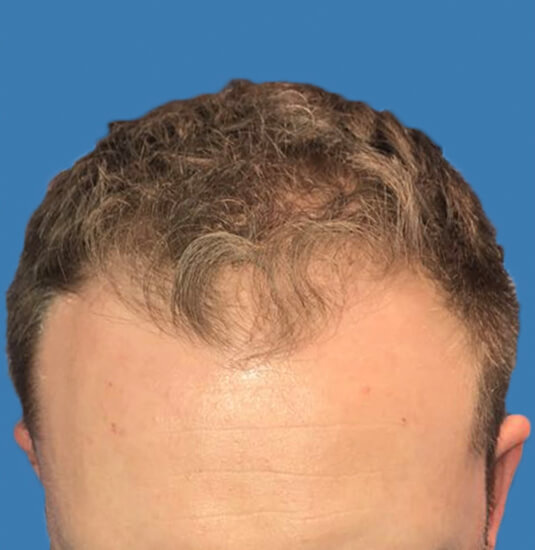Watching your hair thin out or your hairline recede can be super frustrating. While you may be concerned about the way it looks at the moment, you may worry even more about the future. When will your hair loss end? Will you lose all your hair?
Actually, you won’t. Which areas of the scalp are susceptible to hair loss and which aren’t – and what this has to do with hair transplants – is the focus of today’s article.
What to Know About Hair Loss and Hair Restoration
Hair Restoration Trends in the United States
In the United States, an estimated 50 million men and 30 million women experience a form of hair loss called androgenetic alopecia. It can begin as early as a person’s teens and becomes more common with increasing age. A majority of men over 50 have hair loss to some degree. For the purposes of this discussion, we will focus on male pattern baldness, which causes the majority of hair loss in men.
Because hair loss is such a widespread problem, a lot of time and sweat has been spent on finding solutions. And we’re not talking about lotions, potions, and pills here. We’re talking about medical technology.
Even though hair transplants have been around since World War 2, they have only become really popular in the last decade or so. Never before has it been so easy to get a hair transplant as now, and never before has restored hairlooked so completely natural. According to the International Society of Hair Restoration Surgery, worldwide hair restoration surgeries increased by 60% from 2014 to 2017 alone. More recently, the increasing popularity of beard transplants has accelerated this trend even more.
It’s also worth looking at trend lines for the types of hair transplantation procedures. 15 years ago, over 90% of hair transplantation surgeries were Follicular Unit Transplantation or FUT procedures. Just 10 years later, however, that proportion had shrunk to only 50%, while the Follicular Unit Extraction or FUE procedure had rapidly gained ground, making up roughly the other half.

This shift is important, because it is basically the reason why hair transplants have grown so rapidly in popularity. FUE hair transplants have several advantages over FUT hair transplants. To understand this, let’s examine how both technologies work.
FUT vs FUE Hair Restoration
FUT is more commonly known as the Strip Method. A strip of scalp is surgically removed from the back of the head. It is then dissected into thousands of so-called grafts, each graft made up of 1-4 hair follicles. Once separated, these grafts are then individually inserted into the balding areas of the scalp.
FUE differs from FUT in one major way: The donor hair is not removed as a strip of scalp, but rather as individual grafts ready to be transplanted. A device powered by pneumatic pressure is used to pull out the hair grafts. The insertion of the grafts to the balding areas is not very different from FUT. The same pneumatic device uses reverse pressure to punch small holes into the scalp to insert the grafts.
The advantages of FUE over FUT are obvious: By removing the grafts individually, there is no need for a surgical incision on the back of the head, meaning there will also be no linear scar in that spot. This allows patients to wear their hair any way they prefer instead of having to cover up a scar. In addition, the recovery is much easier and faster, since there are no sutures to heal. Instead, the small puncture dots scab over and fall off within days of the procedure, and regular activities, even more strenuous exercise, can be taken up again.




Which Hair is Safe from Hair Loss
Note that both FUT and FUE take donor hair from the same area: The back of your head. Male pattern baldness does not affect all of your scalp. The hair at the back of your head is genetically predisposed to remaining healthy throughout your lifetime. This is the piece of good news in all of this. Not ALL your hair is working against you. Some of your hair is quite literally immune to hair loss, and that is the foundation modern hair transplantation is built on.
If you just kept on losing hair continuously, you probably would be pretty frustrated to have paid $5000 for a hair transplant only to see your precious new hair fall out again. No one would want to do that. But the great thing about hair transplantation is that the new hair will not fall out. Because the follicles are taken from the back of your head, the area that is genetically immune from male pattern baldness, the transplanted hair will carry this genetic protection with it.
This doesn’t mean that one single hair transplant is enough for everyone for the rest of their lives. Some people do need a follow-up hair transplant, depending on the severity of their hair loss, the type and shape of hair, the quality of their first hair transplant, and other factors. We see many patients with a previous FUT procedure who want to touch it up with NeoGraft (i.e. FUE) because they prefer how natural it looks. But in a majority of cases, one hair transplant is sufficient to help patients achieve the full head of hair they are looking for.
This was a lot of information, but it’s really not that complicated. If you send us a few pictures of your scalp, we will tell you if you’re a candidate and prepare a same-day quote for you. Ready to get started? Request your FREE assessment and quote now!
References: International Society of Hair Restoration Surgery

